Multiplication
Multiplication can be thought of as the process of adding the same number multiple times, and is closely related to addition. Taking the example of multiplying four by three, we can achieve the same result using the expression "4 × 3" (four multiplied by three) or "3 + 3 + 3 + 3" (adding four threes together). It should be fairly obvious already that solving all but the most trivial of multiplication problems using one's fingers is not a practical option. For this reason school children traditionally learn the result of multiplying any two small numbers by heart at an early stage of their education. The numbers involved usually range from one to nine or above. In the United Kingdom, the numbers range from one to twelve, and children are expected to learn a set of multiplication tables commonly referred to as the "twelve times tables". The twelve times tables are reproduced below.
| 1 | × | 1 | = | 1 | 1 | × | 2 | = | 2 | 1 | × | 3 | = | 3 | 1 | × | 4 | = | 4 | |||||
| 2 | × | 1 | = | 2 | 2 | × | 2 | = | 4 | 2 | × | 3 | = | 6 | 2 | × | 4 | = | 8 | |||||
| 3 | × | 1 | = | 3 | 3 | × | 2 | = | 6 | 3 | × | 3 | = | 9 | 3 | × | 4 | = | 12 | |||||
| 4 | × | 1 | = | 4 | 4 | × | 2 | = | 8 | 4 | × | 3 | = | 12 | 4 | × | 4 | = | 16 | |||||
| 5 | × | 1 | = | 5 | 5 | × | 2 | = | 10 | 5 | × | 3 | = | 15 | 5 | × | 4 | = | 20 | |||||
| 6 | × | 1 | = | 6 | 6 | × | 2 | = | 12 | 6 | × | 3 | = | 18 | 6 | × | 4 | = | 24 | |||||
| 7 | × | 1 | = | 7 | 7 | × | 2 | = | 14 | 7 | × | 3 | = | 21 | 7 | × | 4 | = | 28 | |||||
| 8 | × | 1 | = | 8 | 8 | × | 2 | = | 16 | 8 | × | 3 | = | 24 | 8 | × | 4 | = | 32 | |||||
| 9 | × | 1 | = | 9 | 9 | × | 2 | = | 18 | 9 | × | 3 | = | 27 | 9 | × | 4 | = | 36 | |||||
| 10 | × | 1 | = | 10 | 10 | × | 2 | = | 20 | 10 | × | 3 | = | 30 | 10 | × | 4 | = | 40 | |||||
| 11 | × | 1 | = | 11 | 11 | × | 2 | = | 22 | 11 | × | 3 | = | 33 | 11 | × | 4 | = | 44 | |||||
| 12 | × | 1 | = | 12 | 12 | × | 2 | = | 24 | 12 | × | 3 | = | 36 | 12 | × | 4 | = | 48 | |||||
| 1 | × | 5 | = | 5 | 1 | × | 6 | = | 6 | 1 | × | 7 | = | 7 | 1 | × | 8 | = | 8 | |||||
| 2 | × | 5 | = | 10 | 2 | × | 6 | = | 12 | 2 | × | 7 | = | 14 | 2 | × | 8 | = | 16 | |||||
| 3 | × | 5 | = | 15 | 3 | × | 6 | = | 18 | 3 | × | 7 | = | 21 | 3 | × | 8 | = | 24 | |||||
| 4 | × | 5 | = | 20 | 4 | × | 6 | = | 24 | 4 | × | 7 | = | 28 | 4 | × | 8 | = | 32 | |||||
| 5 | × | 5 | = | 25 | 5 | × | 6 | = | 30 | 5 | × | 7 | = | 35 | 5 | × | 8 | = | 40 | |||||
| 6 | × | 5 | = | 30 | 6 | × | 6 | = | 36 | 6 | × | 7 | = | 42 | 6 | × | 8 | = | 48 | |||||
| 7 | × | 5 | = | 35 | 7 | × | 6 | = | 42 | 7 | × | 7 | = | 49 | 7 | × | 8 | = | 56 | |||||
| 8 | × | 5 | = | 40 | 8 | × | 6 | = | 48 | 8 | × | 7 | = | 56 | 8 | × | 8 | = | 64 | |||||
| 9 | × | 5 | = | 45 | 9 | × | 6 | = | 54 | 9 | × | 7 | = | 63 | 9 | × | 8 | = | 72 | |||||
| 10 | × | 5 | = | 50 | 10 | × | 6 | = | 60 | 10 | × | 7 | = | 70 | 10 | × | 8 | = | 80 | |||||
| 11 | × | 5 | = | 55 | 11 | × | 6 | = | 66 | 11 | × | 7 | = | 77 | 11 | × | 8 | = | 88 | |||||
| 12 | × | 5 | = | 60 | 12 | × | 6 | = | 72 | 12 | × | 7 | = | 84 | 12 | × | 8 | = | 96 | |||||
| 1 | × | 9 | = | 9 | 1 | × | 10 | = | 10 | 1 | × | 11 | = | 11 | 1 | × | 12 | = | 12 | |||||
| 2 | × | 9 | = | 18 | 2 | × | 10 | = | 20 | 2 | × | 11 | = | 22 | 2 | × | 12 | = | 24 | |||||
| 3 | × | 9 | = | 27 | 3 | × | 10 | = | 30 | 3 | × | 11 | = | 33 | 3 | × | 12 | = | 36 | |||||
| 4 | × | 9 | = | 36 | 4 | × | 10 | = | 40 | 4 | × | 11 | = | 44 | 4 | × | 12 | = | 48 | |||||
| 5 | × | 9 | = | 45 | 5 | × | 10 | = | 50 | 5 | × | 11 | = | 55 | 5 | × | 12 | = | 60 | |||||
| 6 | × | 9 | = | 54 | 6 | × | 10 | = | 60 | 6 | × | 11 | = | 66 | 6 | × | 12 | = | 72 | |||||
| 7 | × | 9 | = | 63 | 7 | × | 10 | = | 70 | 7 | × | 11 | = | 77 | 7 | × | 12 | = | 84 | |||||
| 8 | × | 9 | = | 72 | 8 | × | 10 | = | 80 | 8 | × | 11 | = | 88 | 8 | × | 12 | = | 96 | |||||
| 9 | × | 9 | = | 81 | 9 | × | 10 | = | 90 | 9 | × | 11 | = | 99 | 9 | × | 12 | = | 108 | |||||
| 10 | × | 9 | = | 90 | 10 | × | 10 | = | 100 | 10 | × | 11 | = | 110 | 10 | × | 12 | = | 120 | |||||
| 11 | × | 9 | = | 99 | 11 | × | 10 | = | 110 | 11 | × | 11 | = | 121 | 11 | × | 12 | = | 132 | |||||
| 12 | × | 9 | = | 108 | 12 | × | 10 | = | 120 | 12 | × | 11 | = | 132 | 12 | × | 12 | = | 144 | |||||
The twelve times tables can be considered to comprise 144 "multiplication facts". As with addition, these multiplication facts can be condensed into a lookup table as shown below. The intersection of each row and column gives the result of multiplying the number at the start of the row by the number at the top of the column (or vice versa). Note that the multiplication of any number by zero yields zero, while the multiplication of any number by one simply yields that number.
| 0 | 1 | 2 | 3 | 4 | 5 | 6 | 7 | 8 | 9 | 10 | 11 | 12 |
| 1 | 1 | 2 | 3 | 4 | 5 | 6 | 7 | 8 | 9 | 10 | 11 | 12 |
| 2 | 2 | 4 | 6 | 8 | 10 | 12 | 14 | 16 | 18 | 20 | 22 | 24 |
| 3 | 3 | 6 | 9 | 12 | 15 | 18 | 21 | 24 | 27 | 30 | 33 | 36 |
| 4 | 4 | 8 | 12 | 16 | 20 | 24 | 28 | 32 | 36 | 40 | 44 | 48 |
| 5 | 5 | 10 | 15 | 20 | 25 | 30 | 35 | 40 | 45 | 50 | 55 | 60 |
| 6 | 6 | 12 | 18 | 24 | 30 | 36 | 42 | 48 | 54 | 60 | 66 | 72 |
| 7 | 7 | 14 | 21 | 28 | 35 | 42 | 49 | 56 | 63 | 70 | 77 | 84 |
| 8 | 8 | 16 | 24 | 32 | 40 | 48 | 56 | 64 | 72 | 80 | 88 | 96 |
| 9 | 9 | 18 | 27 | 36 | 45 | 54 | 63 | 72 | 81 | 90 | 99 | 108 |
| 10 | 10 | 20 | 30 | 40 | 50 | 60 | 70 | 80 | 90 | 100 | 110 | 120 |
| 11 | 11 | 22 | 33 | 44 | 55 | 66 | 77 | 88 | 99 | 110 | 121 | 132 |
| 12 | 12 | 24 | 36 | 48 | 60 | 72 | 84 | 96 | 108 | 120 | 132 | 144 |
In multiplication involving two numbers, the terminology used can vary. When multiplication is viewed as the repeated addition of a number, the number to be added is sometimes referred to as the multiplicand, while the number of copies of that number being added together is called the multiplier. However, the two numbers are more commonly referred to simply as factors. The result of multiplying two numbers together is called their product. One of the most common notations for representing the multiplication of one number by another shows the two factors separated by the multiplication sign ("×"). For example, the expression "nine multiplied by five" would be written as: "9 × 5" (this form of notation is called infix notation, by the way). When more than two numbers are being multiplied together, the operation can be written as a series of multiplication operations. For example, the expression "nine multiplied by five, multiplied by seven" could be written as "9 × 5 × 7". Like addition, multiplication is commutative, so the order in which the factors appear in an expression is not important. The following expressions are therefore all equivalent:
9 × 5 × 7 = 315
9 × 7 × 5 = 315
5 × 9 × 7 = 315
5 × 7 × 9 = 315
7 × 9 × 5 = 315
7 × 5 × 9 = 315
Note that for infix notation the result of a multiplication operation (as for addition and subtraction) follows the equals sign. The multiplication sign is sometimes replaced by a period (a . b is the same as a × b) or an interpoint (a · b is the same as a × b), in order to avoid possible confusion when x appears as a term in its own right in algebraic expressions. The interpoint (also known as an interpunct or middle dot ) tends to be used in preference to the period in countries where a period is used as the decimal point. Where the terms in an equation consist entirely or mostly of abstract terms rather than actual numbers, a simple juxtaposition is often used (ab is equivalent to a × b, 5y is equivalent to 5 × y, and 6(4) is equivalent to 6 × 4). In computer programming languages, an asterisk ("*") is used as the multiplication operator, since "×" would be interpreted as a token (a constant or variable name, for example) by the language's interpreter or compiler. Use of the asterisk as the multiplication operator is also common in computer applications such as spreadsheet programs, for similar reasons.
As well as being commutative, multiplication is (like addition) also associative. This means that the order in which the various multiplication operations are carried out within an expression like "9 × 5 × 7" is unimportant, as the same result will be achieved regardless. To illustrate this, the following expressions are equivalent to one another:
(9 × 5) × 7 = 315
9 × (5 × 7) = 315
Multiplication has a distributive property - so called because it allows you to distribute something by breaking it down into separate and discreet components. It is used in algebra, for example, to simplify algebraic expressions by getting rid of parenthesis (brackets). The following examples illustrate how this works:
a(b + c) = ab + ac
5x(x + 3) = 5x2 + 15x
This means if you need to multiply a sum by some quantity, you can first multiply each addend by that quantity and then add the results of the individual multiplication operations (the products) together to get the correct answer. This property of multiplication is also often used to make mental arithmetic involving multiplication easier. For example, if I had to multiply forty-seven by three, and since forty seven is the same as forty plus seven, I could do the sum in my head like this:
3 × 40 = 120
3 × 7 = 21
120 + 21 = 141
Learning multiplication tables means that you should be able to multiply two single-digit numbers in your head with ease. This is essential because it makes it possible to carry out multiplication involving larger numbers without the use of a calculator, using the various techniques available. Some of these techniques are described below. Before looking at them, however, it is worth mentioning a couple of points. First, unlike addition and subtraction, it is often the case that unless we are dealing with pure numbers, the units in which the result of a multiplication operation is expressed are different to the units in which the multiplicands are expressed. It is also possible for the multiplicands themselves to be expressed in different units. The following examples illustrate the point:
8 M × 4.25 M = 34 M2
50 mph × 2.5 hours = 125 miles
The first example above also serves to illustrate the point that the product of two numbers can be expressed graphically as a rectangle, in which the multiplicands represent the length and height of the rectangle and the product represents the area of the rectangle. The second point we want to mention here is that the multiplication of any two quantities in which one of the multiplicands is negative will always result in a negative result. Conversely, if both multiplicands are negative, the result will always be positive. The following examples demonstrate this:
4 × -3 = -12
-7 × -5 = 35
The first method that we are going to look at for manually calculating the result of multiplying two relatively large numbers is sometimes called "Napier's Method". It is credited to John Napier, a Scottish mathematician who lived from circa 1550 to 1617 and made various contributions to mathematics, including the discovery of logarithms. We will demonstrate this method to find the result of multiplying fifty-seven (57) by two hundred and eighty-five (285). The basic idea is to draw a rectangular grid like the one shown below.
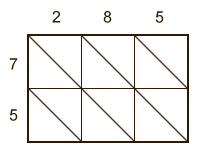
The grid for Napier's method
The digits that make up the two numbers to be multiplied are written to the left of the grid and above it, so that each digit corresponds to a specific row or column in the grid. Note that the digits for 57 are written with the first digit (5) at the bottom of the grid. The order here is important (the numbers should appear in their natural order around the grid, in a clockwise direction). A diagonal line (from top left to bottom right) divides each square in the grid into two parts. For each square in the grid, we must now multiply the numbers above the column and to left of the row in which it appears, and write the result in the square as a two-digit number so that the first digit is in the lower left half of the square, while the second digit is in the upper right half (if the result is a single-digit number, the first digit will be a zero). The illustration below should clarify matters.
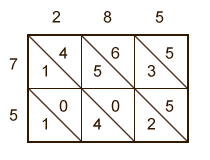
Add the product for each square
The next step is to add the numbers within each diagonal zone together and write the result beneath or to the right of the grid as appropriate.
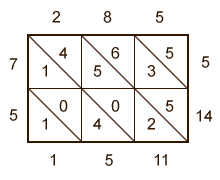
Add the numbers in each diagonal zone
The result is now written from top right to bottom left clockwise around the grid. For any two-digit numbers resulting from the previous step, the digit in the tens column is carried down or left as appropriate, and added to the next number in the sequence. The answer is then read in the opposite direction, starting at the bottom left and moving to top right. The illustration below should clarify how this works.
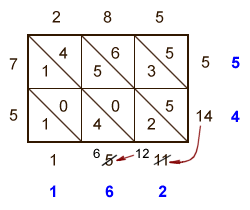
The answer: 57 × 285 = 16,245
A slightly less complicated method that also uses a grid is the "Box Method". For this method, the two numbers to be multiplied are broken down into their constituent parts (i.e. units, tens, hundreds etc.) The grid is constructed so that each part of one number can be written above one column in the grid (normally left to right), and each part of the second number can be written to the left of one row in the grid (normally top to bottom). Note that for this method, the order in which the digits are written is not important. Using the same numbers as previously, here is our Box Method grid:
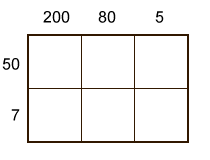
The numbers are broken into units, tens, hundreds etc.
To each box in the grid, add the result of multiplying the numbers corresponding to the row and column for which it forms the intersection:
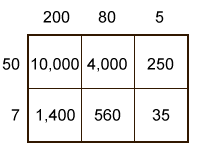
Multiply the number to the left of each row by the number at the top of
each column and write the answer in the intersecting square
Note that the multiplication operations involved are effectively all single-digit affairs, with the catch being that you need to know how many zeros to add on to make sure your answer is of the correct magnitude. This is not really a problem though - just count how many zeros there are in total and add that many zeros to the result of doing the single digit multiplication. For example, 50 × 200 = 5 × 2 × 103, or ten followed by three zeros (10,000). Once you have filled the grid with numbers, you just add them up to get the answer:
0 1 0 , 0 0 0
+ 0 4 , 0 0 0
+ 0 1 , 4 0 0
+ 0 0 , 5 6 0
+ 0 0 , 2 5 0
+ 0 0 , 0 3 5
= 1 6 , 2 4 5
0 0 1 , 1
The last method we will demonstrate here, using the same numbers as before, is the somewhat more traditional method of "Long Multiplication". For this method, we start by stacking the numbers one above the other:
0 , 2 8 5
× , 0 5 7
We then multiply 285 × 7, one digit at a time, writing the result of each calculation beneath the line in the appropriate column and remembering to carry left for intermediate results of greater than nine:
0 , 2 8 5
× , 0 5 7
1 , 9 9 5
0 , 5 3
The calculations in the stage above go like this:
- 7 × 5 = 35. Write the 5 in the "units" column, and carry the 3 under the "tens" column.
- 7 × 8 = 56, plus the carried 3 gives us 59. Write the 9 in the "tens" column, and carry the 5 under the "hundreds" column.
- 7 × 2 = 14, plus the carried 5 gives us 19. Write the 9 in the "hundreds" column, and carry the 1 into the "thousands" column.
In the next stage, we multiply 285 by 5, one digit at a time, this time remembering to put a 0 in the "units" column first because the 5 is already in the "tens" column (note that previously carried digits have been removed for clarity):
0 0 , 2 8 5
0 × , 0 5 7
0 1 , 9 9 5
0 0 , 5 3
1 4 , 2 5 0
0 4 , 2 0 0
The calculations in this stage go like this:
- 5 × 5 = 25. Write the 5 in the "tens" column, and carry the 2 under the "hundreds" column.
- 5 × 8 = 40, plus the carried 2 gives us 42. Write the 2 in the "hundreds" column, and carry the 4 under the "thousands" column.
- 5 × 2 = 10, plus the carried 4 gives us 14. Write the 4 in the "thousands" column, and carry the 1 into the "ten thousands" column.
The next step is to add the two results we have obtained together.
0 0 0 , 2 8 5
0 0 × , 0 5 7
0 0 1 , 9 9 5
0 0 0 , 5 3
+ 1 4 , 2 5 0
0 0 4 , 2 0 0
= 1 6 , 2 4 5
0 0 1 , 1
The manual methods described above can be used for larger numbers, and even for real numbers (numbers that have a fractional element). However, while it is certainly a good idea to be able to carry out the multiplication of large numbers using such methods (and may be a requirement for some examination scenarios), there comes a point where the use of a calculator is simply more efficient. Even before the availability of cheap pocket calculators, complex calculations involving multiplication could be carried out very quickly and with a fair degree of accuracy using a slide rule or logarithmic tables (providing you knew how to use them, of course!) Nevertheless, being able to solve a moderately complex multiplication problem using only a pencil and paper is a useful skill to have, especially if you don't always have a calculator to hand.
